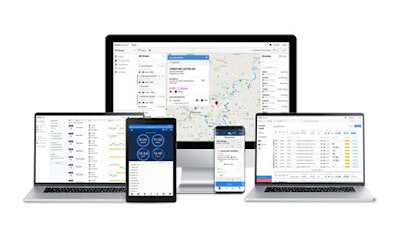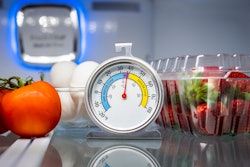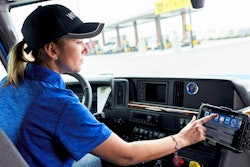
When the Coronavirus disease (COVID-19) hit, many facets of the supply chain experienced disruption. Restaurants closed, some permanently. Excess food went to waste. E-commerce boomed, further fueling the “Amazon Effect.” And, the ever-present driver shortage gap transformed into an overall industry-wide labor shortage issue.
However, despite all of the hiccups and disruptions, trucks kept on truckin’.
In Food Logistics’ August 2021 issue, editor-in-chief Marina Mayer talks with several industry experts about how the global 3PL market continues to play a pivotal role in how and why Americans receive essential goods in a safe and timely manner.
Here’s an interview with Avi Geller, CEO of Maven Machines, with excerpts publishing in Food Logistics’ August 2021 issue. [CLICK HERE to read the article in full].
Food Logistics: The 3PL market is set to grow to become an over $1.8 trillion sector by 2026, according to Global Market Insights, Inc. From your vantage point, what are some contributing factors to this growth?
Avi Geller: In addition to the rising trend of globalization and significant e-commerce growth, fleets and trucking companies that have embraced digital transformation are benefitting. The newer technologies — through automation and workflow management, for example — have helped reduce operating costs and enabled those in the 3PL market to focus on expanding their core business. Digital transformation also helps to support both the infrastructure and services companies need to supply B2B, B2C and e-commerce solutions to their own customers.
We’re seeing a growing demand for international and domestic trade here in the U.S. Although 3PL has always encompassed warehousing and transportation, over half of shipping companies partner with 3PL companies to save time and money and optimize processes.
Food Logistics: The transportation and supply chain industry continues to face supply chain disruption after supply chain disruption. How is your company working to overcome these challenges? (think technology, re-training drivers, etc.)
Geller: Maven Machines provides fleet management technology that helps trucking companies more efficiently manage a wide array of operational and supply chain challenges. During the pandemic, many fleets faced both fluctuating and skyrocketing demands. That demand continues to surge in many trucking sectors, and fleets continue facing challenges about how best to pick up and deliver shipments on-time and without disruption. This increasing pressure to remain competitive coupled with the driver shortage is top-of-mind for many fleets. Fleets need and rely on optimization software that helps them manage their mission critical operations and their drivers more effectively.
Maven provides fleets with a comprehensive, cloud-based platform, giving fleet leaders and managers real-time visibility into data and drivers and enabling them to process more shipments daily. Drivers can deliver more of their loads on time by using software that simplifies their workflows. Planners, dispatchers and managers can monitor KPIs and manage their terminals, plans and routes more productively. Maven continually works directly with our customers to define and understand their unique challenges and evolving business needs. We remain committed to innovating and adding new and improved capabilities to our software that surpass expectations and empower fleets to proactively address future challenges.
Food Logistics: The driver shortage continues to plague the industry. What is your company doing to hire/retain drivers and/or attract new talent?
Geller: The driver shortage is serious. In fact, fleets have 80,000 fewer drivers on the roads in 2021 than in 2020. Wages and benefits remain a top concern for drivers. However, trucking companies embracing digital transformation will more likely see success increasing the numbers in their driver and hiring pipelines. Today’s drivers are more familiar with trucking technology — they want and expect up-to-date software that’s designed to help them do their jobs better, more efficiently and more safely.
Our company has developed easy-to-use, driver-friendly software that facilitates increased productivity for both drivers and managers by automating much of the daily rote work required of both drivers and fleet personnel. By reducing paperwork and reducing some of the frustrations often associated with technology, we allow drivers to focus on the road and improve their overall work experience, which can lead to increased driver satisfaction and retention rates within fleets.
Maven’s platform also helps streamline the driver onboarding and training process by enabling trucking companies to conduct driver education remotely. Because fleet management software can help cultivate and foster supportive environments, trucking companies should adopt and implement these tools and technology to help them retain the best drivers and attract new talent.
Food Logistics: To piggyback on this, what changes need to be made (whether it be government, technology, regulations, etc.) to turn this shortage around?
Geller: To help resolve the driving shortage, trucking companies have many options available, including:
● Increasing pay and safety bonuses.
● Providing more driver training and coaching, and now we have the technology to do much of this remotely.
● Providing opportunities for promotions and upward mobility, especially within the larger fleets.
● Expanding recruiting efforts to larger cities or in other areas of the country and to other demographics, including women and minorities.
● Connecting to and cultivating relationships with industry groups and associations to develop innovative outreach initiatives.
● Providing drivers with tools that enable their success, including more intuitive mobile apps and workflow technologies that help them stay safe and productive.
Food Logistics: Driver safety is also of top concern. What is your company doing to ensure driver safety?
Geller: Fleet safety is critical, and we’ve developed many innovative features for improving driver safety. Whether it’s helping drivers and managers track hours of service (HOS) quickly and accurately, or monitoring vehicle movements and events like harsh braking, our cloud-based software platform is built to help fleets of all sizes improve their safety standards and records. Maven Machines also collects data to provide real-time views and historical reporting on drivers, routes and other fleet activity. This insight allows planners, dispatchers and managers to create and update plans that improve driver safety. Fleet managers can also monitor road conditions and workflows and communicate updates directly to drivers.
Maven’s routing software uses artificial intelligence (AI) and machine learning (ML) to create efficient, optimized routes so drivers don’t feel the need to speed or cut corners to make deliveries and pickups on time. Telematics can help detect poor or potentially dangerous driving behavior, provide fleets with visibility into their top-performing drivers and collate data that fleets can use to guide future training and professional development.
Food Logistics: How does something like the COVID-19 pandemic affect the way 3PLs operate?
Geller: Initially, we saw a ripple effect in how the shipping industry dealt with warehouse and manufacturing closures, staff shortages, unpredictable consumer behavior and general instability along the entire supply chain.
While most manufacturers had adopted lean manufacturing as a best practice pre-pandemic, the extreme shortages resulting from the interrupted supply chain will likely have many rethinking that approach to keep a bit more inventory on hand as a buffer.
We’ll see an increase in the adoption of automation to drive workflow management, storage and retrieval and increased operational efficiency. There may be a greater reliance on 3PL distribution networks, with smaller, decentralized warehouses closer to the customers, which means trucking and fleet companies will take on more last-mile deliveries.
Food Logistics: What does the future look like post-COVID-19? What should companies be doing now to secure a stronger, more resilient fleet in the future?
Geller: Everyone should continue to embrace digital transformation moving forward. Fleets had already been in the midst of a tech-driven revolution prior to the pandemic. Trucking companies with robust digital capabilities have the advantage. They should continue investing in the Internet of Things (IoT), data analytics, workflow software and automation. And, these investments will hold them in good stead for potential long-term advances in robotics, drones and even autonomous vehicles.
Food Logistics: What are some things not addressed above that may be pertinent to our readers?
Geller: When evaluating technology providers, fleets must start considering their long-term future plans for growth; not just present needs or short-term challenges. The technology provider should be forward-thinking with a broad, visionary approach to innovation and industry progress. Trucking companies should position themselves to grow with their technology providers, and in large part, because of their technology providers. For best results, fleets and technology providers should establish a partnered approach to their relationship from the start. Fleet decision makers should only engage with technology providers invested in developing modern solutions to proactively resolve problems and advance fleet operations. A good technology provider collaborates with its customers and helps plan five-, 10- and 20-year goals because they’re committed to the partnership for the long haul.
To ensure operational success and longevity, fleets must leverage cutting-edge solutions elevating them above their competition for both the present and the future.
[CLICK HERE to read the article in full].




















